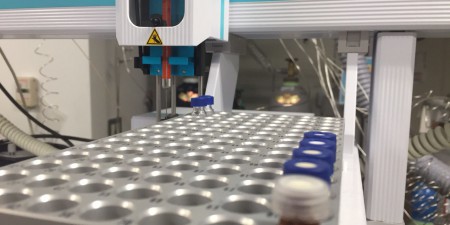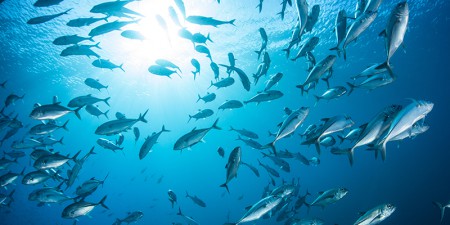Our research in this project is focused on the development of new technologies that use stable isotope ratios of carbon and nitrogen contained in various organic and inorganic compounds found in marine life and in ocean environments, as well as the ratios of radioactive carbon (carbon 14). Our aim to analyze the cycle of matter and the history of the organismal growth and migration in marine ecological systems.
Ecosystem analysis using carbon 14
We here present an example of a research study that uses carbon 14.
Isotope ratios for radiocarbon among dissolved inorganic carbon differ significantly between the Kuroshio (black tide), which originates from low-latitude regions of the Pacific Ocean, and the Oyashio, which originates from subarctic regions of the Pacific Ocean after a long journey traversing a vast oceanic circulation route. Whereas the dissolved inorganic carbon found in the Oyashio current is poor in carbon 14 (exhibits low ∆14C), the dissolved inorganic carbon found in Kuroshio water exhibits high ∆14C. Dissolved inorganic carbon is incorporated into phytoplankton, seaweed, and other photosynthesizing species, and is transformed into organic matter; when this happens, the ∆14C value of the dissolved inorganic carbon is “stamped” onto the organic matter. Thus, plant matter originating in Oyashio water will have low ∆14C, while plant matter originating in Kuroshio water will have high ∆14C. Sanriku is located at the confluence of the Kuroshio and Oyashio currents. Measurements of ∆14C taken on side leaves (blades) of wakame seaweed at Otsuchi Bay on the Sanriku coast revealed high ∆14C values for the blades formed when the bay was filled with Kuroshio water, but low values for the blades formed after the Oyashio water had entered the bay.
Phytoplankton and seaweed provide sustenance to plant eaters (herbivores), and herbivores are eventually eaten by predators; we believe that ∆14C values are preserved through such food-chain processes. Thus, we expect that fish that eat large amounts of Kuroshio phytoplankton will have high values of ∆14C, while fish depending on Oyashio phytoplankton will have low values of ∆14C. To test this hypothesis, we measured ∆14C for 20 types of fish captured off the coast of Sanriku in the Tohoku region of Japan. Measurements revealed that the fish mainly migrate in Kuroshio had high levels of ∆14C, while the fish reseeds in Oyashio exhibited relatively low ∆14C values. The evidence obtained by this study strongly suggested that this basic principle will lead to the development of new methods capable of offering valuable information on the feeding grounds and migration histories of a variety of marine life, including fishery stock.


